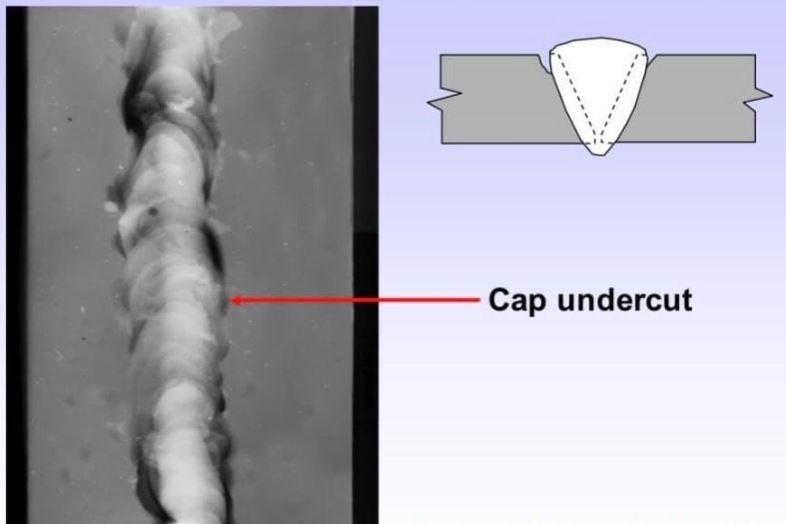Preventing Weld Undercut: Proven Approaches Every Welder Should Know
Preventing Weld Undercut: Proven Approaches Every Welder Should Know
Blog Article
Comprehending the Causes and Solutions for Undercut Welding in Steel Manufacture Processes
In the world of steel fabrication processes, the occurrence of undercut welding presents a considerable difficulty that demands a thorough understanding of its causes and viable options. The complex interaction of numerous variables during welding procedures can bring about this unfavorable sensation, influencing the structural honesty and total top quality of the welded joints - Preventing weld undercut. By studying the origin of undercut welding and discovering efficient remedial measures, producers can raise the criterion of their workmanship and guarantee the production of flawless steel parts
Typical Causes of Undercut Welding
Frequently overlooked in steel fabrication, undercut welding happens as a result of numerous aspects that demand meticulous interest and knowledge to be effectively alleviated. One common source of undercut welding is excessive heat input. When the warmth input is also high, it can result in the melting and succeeding disintegration of the base material along the sides of the weld joint, developing a groove or undercut. Furthermore, improper welding techniques, such as utilizing the wrong welding angle or travel speed, can additionally add to damage formation. Insufficient securing gas coverage is an additional essential element that can result in damaging. Not enough gas coverage falls short to safeguard the weld pool adequately, leading to oxidation and undercut issues. The choice of welding criteria, such as voltage, current, and cable feed rate, plays a considerable duty in the occurrence of undercut welding. Understanding these typical causes is crucial for executing safety nets and guaranteeing high-quality welds in steel manufacture processes.
Influence of Incorrect Welding Parameters
Unreliable welding parameters can substantially jeopardize the stability and top quality of bonded joints in steel construction procedures. The impact of inaccurate welding parameters shows up in different means, leading to architectural weaknesses and problems in the welded components. Thorough interest to welding specifications is critical to guarantee the production of premium welds with the desired mechanical residential or commercial properties and architectural honesty.
Impact of Improper Lantern Angle
Inappropriate torch angle in welding procedures can substantially influence the quality and stability of the final weld joints in steel manufacture procedures. The lantern angle plays a critical function in determining the warm input and circulation during welding. When the torch angle is inaccurate, issues such as damaging can arise. Undercutting is an usual welding problem where a groove develops along the weld toe, compromising the joint and compromising its architectural integrity.
A lantern angle that is too steep can lead to not enough infiltration, incomplete blend, and boosted spatter. On the various other hand, a torch angle that is as well shallow can lead to extreme infiltration, burn-through, and distortion of the base material. Preventing weld undercut. Appropriate torch angle is necessary for ensuring constant weld top quality, strength, and appearance
To stop damaging and other problems brought on by improper lantern angles, welders have to be trained to keep the proper torch angle throughout the welding procedure. Normal monitoring and modification of lantern angles throughout welding can help achieve sound welds with very little problems.
Role of Inadequate Welding Techniques

An additional element of insufficient welding methods is improper weld prep Home Page work. Inadequate cleansing of the base metals, incorrect joint design, or not enough edge prep work can all contribute to undercut welding. Moreover, inadequate securing gas coverage or utilizing the wrong kind of Get More Information gas can lead to insufficient fusion and the formation of undercut issues.
To attend to the duty of poor welding methods in steel fabrication procedures, it is important to supply extensive training for welders. Correct education and learning on welding specifications, joint preparation, and protecting gas selection can assist stop undercut welding and make certain high-grade welds in steel manufacture jobs.
Efficient Solutions for Undercut Welding
Dealing with undercut welding in metal fabrication requires carrying out reliable options to boost weld high quality and structural integrity. One of the primary services to fight undercut is to adjust welding parameters such as voltage, current, and travel speed to guarantee proper warm input and fusion. By fine-tuning these settings, welders can prevent extreme melting of the base metal and filler product, decreasing the chance of undercut formation.
Furthermore, correct joint preparation is essential in protecting against undercut. Making certain clean base steel surface areas cost-free of contaminants and making use of the proper bevel angle can help advertise much better weld penetration and decrease the threat of undercut - Preventing weld undercut. Using ideal welding methods, such as weaving or oscillating the lantern, can likewise aid in dispersing warmth equally and loading the weld joint adequately, decreasing the opportunity of undercut problems
Moreover, choosing the right welding consumables, including electrodes and filler steels, is vital in mitigating undercut. Utilizing products with suitable chemical make-ups and mechanical buildings can add to accomplishing sound welds with minimal undercut. Routine inspection and quality assurance steps ought to likewise be carried out to detect and deal with undercut concerns quickly, making certain the overall integrity of made steel parts.

Final Thought
To conclude, understanding the causes and remedies for undercut welding in metal fabrication processes is essential for achieving high-quality welds. By resolving usual reasons such as wrong welding parameters, incorrect lantern angle, and inadequate welding strategies, welders can prevent undercutting and make sure solid, resilient welds. It is important to take notice of these variables and implement efficient services to site link improve the total welding process and last item top quality.

Report this page